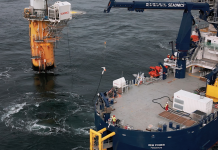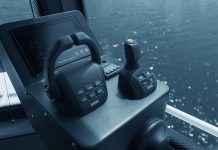New Avionics Corp manufactures modern ice sensors for wind farms, manned and unmanned aircraft, commercial refrigerators, sensing the formation of hazardous ice for corrective action. NAC’s Ice*Meister™ Model 9734-SYSTEM was introduced to the wind-power community in March of 2010 and has since proven itself at wind-power farms and other industrial sites across the northern hemisphere.
The technology is entirely optical. With no moving parts, Model 9734 has been constantly improved with new optical configurations and lower-cost manufacturing techniques. This evolves continuously into smaller, lighter, more sensitive ice detectors at lower prices.
Since 2010, the 9734 ice sensor has shrunk from a nacelle-top sensor head the size of a human fist with a large rail-mounted DIN box inside the nacelle, to a single epoxy-filled unit the size of a thumb. Price and discount schedules for 2018 have likewise shrunk to less than half the original prices of 2010.
In operation, the 9734 monitors the wind turbine’s immediate meteorological environment for real-time formation of an icing domain. It works on the principle of refraction. When air is in contact with the probe surfaces, it senses the optical characteristics of that air and reports no ice. When ice is in contact with the probe surfaces, it senses the optical characteristics of that ice and reports ice alert.
Turbine bearings heat signature
NAC’s ice-sensing technology is also found on fixed-wing aircraft, with well over 5,000 hours flight time and more than 18 continuous hours per mission in electrically-propelled UAVs.
Ice*Meister™ works in ice-protected autonomous drone aircraft for fixed-schedule operations in wind-turbine farms, regardless of rain, cold, ice, or snow, much as commercial and military aircraft do everyday.
New Avionics ice-sensing technology is size-appropriate, weight-appropriate, and cost-appropriate to modern drone aircraft. It opens the door to inspection drones for wind-power farms, suitably equipped with digital maps and flight algorithms; infrared, visual and Lidar cameras; multiple swappable batteries, housed in local “garages” similar to drone prototypes for rural Federal Express delivery vans.
%%0418-NAC%%
On fixed schedule under SCADA control, each autonomous drone would take off and fly a specific circuit of turbines, record high resolution images of turbine blades and other key features, then fly to the next turbine much like a honey bee collecting nectar in a field of flowers, returning to its garage for battery charge or swap as required.
In the unlikely event of fire or other anomaly, SCADA would immediately dispatch its drone for video monitoring and situational awareness before technicians and fire apparatus could arrive.
Wind-farm drones would also be night watchmen, with heat-sensitive infrared cameras that would alert operators of intruders, the movement of wildlife at night, or flocks of birds, sounding a horn to shoo them away. It would also monitor the heat signature of turbine bearings and other equipment for signs of impending failure.
In addition to end-of-warranty inspections and preventive maintenance, inherent advantages of ice-protected autonomous drones include safety, objectivity, uniformity, accuracy, low cost, and real-time dissemination of critical data.
None of the above would be possible without Ice*Meister™ modern ice sensing and protection for drone aircraft operating fixed-schedule missions in ice and snow.
Such are the recent advancements in ice sensors for wind turbines, made possible by New Avionics Corporation.
Source: New Avionics Corp.
For more information, go to www.newavionics.com



























